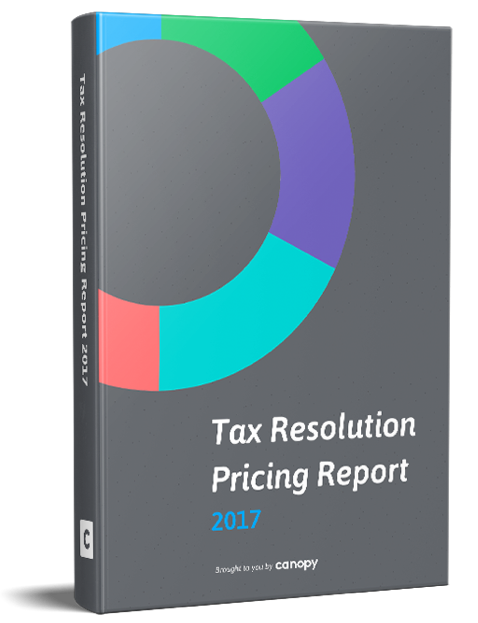What is Tax Resolution?
Tax resolution is the umbrella term for services that aid taxpayers when they run afoul of the IRS. Sometimes called IRS representation, tax problem recovery, or tax controversy, tax resolution services are in high demand. Those services include Offer in Compromise assistance, lien and levy relief, penalty abatement, and more. We’ll cover common types of tax resolution in more detail later.
Why You Should Offer Tax Resolution
There are a lot of great reasons tax pros across the country are increasingly offering tax resolution services, but let’s take a quick look at the big three.
1. Non-seasonal Income
People who have IRS problems need help all year long, not just from February to April. Rather than having to earn the majority of your income in the few months deemed “tax season,” offering tax resolution services allows you to earn a steady income all year long.
2. Make More Money
Do you want to increase your income 8-23x? Add tax resolution services to your practice. Tax preparation pays an average of just $21.43/ hour. Tax resolution, on the other hand, is worth anywhere from $175-$500/ hour.
3. Increased Satisfaction
Even in an industry where numbers are everything, it’s difficult to quantify something like satisfaction. However, there is an almost universal agreement among tax professionals that tax resolution work is far more satisfying (not to mention less repetitive) than tax preparation.
How to Start Offering Tax Resolution Services
Getting certified to represent clients before the IRS and offer tax resolution isn’t a complicated process, especially if you’re already a certified enrolled agent, CPA, or attorney. Let’s take at the four things you’ll need to do to get certified to offer tax resolution services.
Become an Enrolled Tax Preparer
In order to properly represent your client, you’ll need to submit IRS Form 2848 and obtain power of attorney for your client (covered in more detail below). Only enrolled agents, CPAs, and attorneys will be granted power of attorney by the IRS, so your first step is to get the proper professional certification. If you’re not already a CPA or attorney, your best path is probably to become an EA which doesn’t require any additional schooling.
Get Your CAF Number
A CAF number is a nine-digit number assigned to you by the IRS the first time you file a Form 2848 (power of attorney). The number is used by the IRS to track your requests for client information, such as transcripts.
The first time you file a 2848, simply write “none” in the space designated for your CAF number, and the IRS will send you a letter with your CAF number. You will only have to apply for a CAF number once and will use the same CAF number for each case going forward.
Obtain Power of Attorney
The only other legal paperwork you need to have in order to do tax resolution work is power of attorney (Form 2848). Having power of attorney gives you the legal right to represent your client before the IRS. A new power of attorney will have to be filed for each client.
Learn the Ropes
Getting certified to offer tax resolution services may be a relatively simple process, but the work itself requires a certain amount of learning on your part. Fortunately, there are a ton of resources out there to help you learn how to help your clients’ resolve their tax problems. In addition to traditional learning methods such as conferences and webinars, the internet offers a ton of great, easy-to-access information about tax resolution. Blog articles and ebooks are great places to learn the ins and outs of tax resolution.
It’s also probably worth your time to look into a good tax resolution software. Good tax resolution software will make your life easier by doing all of the complex computations, suggesting the outcomes most likely to be accepted by the IRS, and keeping track of ever-changing tax codes so you don’t have to.
Getting Paid for Tax Resolution Services
You’re probably not looking to do tax resolution for free, so it’s important to come up with a plan for how much to charge for your services and how to collect payment from your clients.
Pricing Tax Resolution Services
There is no universal method for pricing your tax resolution services. That said, there are some basic principles to consider when choosing how much you should charge your clients.
1. Know how much your service is worth.
What kind of value are you providing to your client? Relief is hard to calculate, but you can put an exact number to how much money you have saved your client—your pricing should reflect that.
2. Know your market.
Knowing your market isn’t just about seeing how much other practices charge for tax resolution. When deciding how to structure your pricing, it’s just as important to keep your client base in mind.
Do most of your clients have simple problems and limited budgets? A flat fee might be the best pricing structure for you. Do you tend to work with wealthy clients and businesses whose finances are often unpredictable and complex? A per-hour pricing structure may be the best way to ensure that you get paid sufficiently for your services.
Collecting Payment for Tax Resolution Services
Collecting payment can be stressful, especially when you’re working with people who are already struggling under the weight of their IRS problems. However, much of that stress can be mitigated by collecting partial payment before you begin any work.
We suggest charging a nominal upfront fee (in the range of $500) to pull the client’s transcripts and and have a consultation. Charging a small amount—rather than your full fee—will help you build trust with the client in addition to ensuring that your are working with someone who is both serious about solving their tax problem and able to pay you for your services.
Of course, you want to collect the rest of the payment with as little hassle as possible. The easier you can make it for clients to pay you, the more likely you are to get paid—and get paid faster. Letting clients pay through an online billing platform (like Canopy’s) is not just more convenient, it actually helps you collect more money, faster.
Common Types of Tax Resolution
Installment Agreement
Under an installment agreement, the taxpayer agrees to pay the entire amount of their debt in monthly installments over a period of up to six years. This method allows the taxpayer to pay in small, manageable amounts so that the debt is not overwhelming. You can request an installment agreement using IRS Form 9465.
Partial Payment Installment Agreement
A partial payment installment agreement, or PPIA, is like an installment agreement, except that a combination of the statute of limitations and the taxpayer’s ability to pay means that the tax debt doesn’t have to be settled in full.
Statute of limitations laws prohibit the IRS from attempting to collect on a given tax debt indefinitely, regardless of a taxpayer’s ability to pay. The statute of limitations (CSED) on collecting taxes is typically 10 years from the date the tax was assessed, though there are several circumstances that can extend the expiration date. Once the CSED has passed, the IRS can no longer legally collect the taxes in question, and the debt is effectively forgiven.
Inevitably, some taxpayers are unable to fully pay off their tax debt before the collections statute expires. Still, the IRS recognizes that partial payment is better than no payment, so they encourage taxpayers to pay as much as they are able until the collection date has expired. The result is an PPIA.
Offer In Compromise
An offer in compromise (OIC) is an option offered by the IRS that allows a taxpayer to settle their debt for less than what is actually owed. This option is great for a taxpayer because it gives them a fresh start with the IRS, but the ultimate goal of an offer in compromise is to come to a legal agreement for payment that’s in the best interest of both the taxpayer and the IRS.
The three grounds for submitting an offer in compromise are doubt as to collectibility, doubt as to liability, and effective tax administration.
Offer in Compromise is complex enough that it gets a whole guide all to itself. Check it out to learn everything you need to know about OIC’s from a former IRS Revenue Officer.
Suggested: The Ultimate Guide to Offer in Compromise from an Ex-IRS Revenue Officer
Penalty Abatement
Tax penalties can stack up fast, so know how to get them abated can mean big savings for your clients. Let’s take a quick look at two common types of penalty abatement.
First Time Penalty Abatement
First time penalty abatement, or FTA, is a one-time, get-out-of-jail-free card of sorts for abating certain penalties. The abatement is intended for taxpayers who are typically on top of their taxes, but for some reason, life hit them broadside and they fell behind one year.
The requirements for FTA are as follows:
- FTA can only abate three types of penalties—Failure to Pay, Failure to Deposit, and Failure to File.
- The taxpayer must have at least three years of clean tax history immediately prior to the year they wish to use FTA.
- The taxpayer must currently be in compliance. This means having filed all required returns ora valid extension and paying or arranging to pay all taxes due.
If the taxpayer meets the specific set of qualifications, they are eligible for the abatement. However, because FTA is a one-time option, you may want to look at a few other options first if your client has penalties stretching across multiple tax years.
Reasonable Cause
When you come to the IRS and invoke Reasonable Cause in an effort to get a tax abatement, you are essentially saying the taxpayer has a really good excuse for whatever behavior it was that led to their tax penalty. Because Reasonable Cause situations are often multifaceted and complex, Reasonable Cause can’t be quantified in the same way as FTA. However, this also means you have much more room to work when trying to use Reasonable Cause in order to get penalties abated.
There are dozens of scenarios that can qualify as Reasonable Cause (ex. death, serious injury, or unavoidable absence). They often overlap, allowing you to cite more than one at a time. It would be a good idea to make yourself familiar with section 20 of the IRM. Reference specific sections and codes from IRM directly whenever possible when talking to the IRS. They have to input IRM specific codes into their software as they evaluate each case, so the more precise you can be, the better.
One universal point that you will have to prove in any case of Reasonable Cause is “ordinary business care and prudence.” That phrase is all over section 20 of the IRM. When asking for a Reasonable Cause Abatement, the IRS will want you to prove that the taxpayer made a reasonable effort to meet their obligations. This effort will be a little different for each person, and in each scenario, establishing a taxpayer’s effort at ordinary business care and prudence will be central to any successful Reasonable Cause Abatement.
Lien Relief
By issuing a lien, the IRS is asserting a legal right to a taxpayer’s property as a security against debt the taxpayer who owes to the IRS. Essentially, the IRS is stating their claim on the taxpayer’s assets. That claim, if left unchecked, will eventually end with the IRS seizing the taxpayer’s assets—bank accounts, valuables, real assets with equity—in an attempt to fulfill the outstanding tax debt.
The purpose of issuing a lien is to inform other creditors that the IRS now has legal right to the taxpayer’s property.
Lien Release
When a lien is released, your client’s property or assets are no longer encumbered and subject to seizure by the IRS. More plainly, the IRS releases their claim on the assets.
A lien release gets rid of most of the immediate effects of a lien. Because the IRS no longer has any interest in the assets, your client may sell or transfer their assets at will.
The IRS will release a lien 30 days after the tax debt has either been satisfied, or becomes legally unenforceable. If your client can afford to pay their debt, or has the ability to borrow sufficiently to pay their debt, it’s often best to simply pay what’s owed. The IRS is also legally obligated to release a lien if the tax debt has been discharged in bankruptcy or if the statute of limitations (CSED) has expired for the collection of the tax debt.
Lien Withdrawal
While a lean release is an acceptable solution for your client in many cases, a release does not solve all the problems created by a lien. Most notably, a lien release does not address damages done to the taxpayers ability to obtain credit.
A withdrawal, on the other hand, erases the lien as though it had never existed—thus restoring your client’s credit score to pre-lien status.
IRS Form 12277, Application for Withdrawal of Federal Tax Lien lists four reasons the IRS will consider withdrawing the lien.
- “The Notice of Federal Tax Lien was filed prematurely or not in accordance with IRS procedures.”
- “The taxpayer entered into an installment agreement to satisfy the liability for which the lien was imposed and the agreement did not provide for a Notice of Federal Tax Lien to be filed.”
- “Withdrawal will facilitate the collection of the tax.”
- “The taxpayer, or the Taxpayer Advocate acting on behalf of the taxpayer, believes withdrawal is in the best interest of the taxpayer and the government.”
IRS Form 12277, Application for Withdrawal of Federal Tax Lien lists four reasons the IRS will consider withdrawing the lien.
- “The Notice of Federal Tax Lien was filed prematurely or not in accordance with IRS procedures.”
- “The taxpayer entered into an installment agreement to satisfy the liability for which the lien was imposed and the agreement did not provide for a Notice of Federal Tax Lien to be filed."
- “Withdrawal will facilitate the collection of the tax.”
- “The taxpayer, or the Taxpayer Advocate acting on behalf of the taxpayer, believes withdrawal is in the best interest of the taxpayer and the government.”
We go into more detail in our free ebook, A Basic Guide to Liens and Levies.
Levy Relief
When the IRS levies a taxpayer’s asset, that asset becomes the property of the United States Government. It’s an expensive and relatively inefficient way of collecting taxes, but sometimes taxpayers leave the IRS with no other choice. If a taxpayer ignores months’ worth of requests and notices urging them to address their outstanding tax balance, the IRS will levy the taxpayer’s assets in an attempt to pay down the tax bill.
But what if the taxpayer wants their levied assets back? Can a tax pro help their client recover levied assets from the IRS? The short answer is sometimes.
The IRS may return levied property (or the cash value thereof) if:
- The IRS levied the asset illegally, prematurely, or not according to IRS procedures
- An installment agreement is made for a liability included on the levy
- Returning the property will facilitate collection
- Returning the property is in the best interest of the Government
Currently Not Collectible
A taxpayer can have all collection activity halted if they are under “Currently Not Collectible” status. This status is only for taxpayers whose expenses exceed their income. The IRS will look at national standards in order to determine if the taxpayer could afford their basic living expenses.
Working with the IRS
You do your best to be thorough and professional on all of your tax resolution cases, but once you’ve submitted them to the IRS, the fate of these cases is up to the agent you’re working with. This loss of control can be anxiety-inducing, but you can actually have a big impact on the outcome of your clients’ cases by being aware of how you interact with the IRS throughout the process. In this section, we’ll highlight 10
-
Be Professional
The person who answers your phone call at the IRS has likely been talking to taxpayers and other tax professionals all day long. They inevitably have to work with people who are rude, irrational, and combative. Set yourself apart by being professional. You can be polite and agreeable while also being firm and assertive.
-
Be on Time
The IRS processes hundreds of thousands of requests—extensions, offers, payment plans, settlement agreements—every year. They’re understaffed, overwhelmed, and happy to reject your request if you give them a good excuse. And late paperwork? There’s no simpler excuse for rejection.
That means deadlines are now sacred to you. Ditch your old pen-and-paper planner and optimize your workflow by using software to track upcoming tasks and deadlines. Set regular reminders for yourself, and schedule a weekly meeting (even if you’re the only attendee) where you map out all of your upcoming deadlines. Missed deadlines should never be a problem you have when working with the IRS. -
Fill Everything Out Correctly
Speaking of simple reasons for rejection, filling out forms incorrectly is another efficient way to get your request summarily shredded. Make sure you’re using the right forms. Make sure you put the right information in the right place. Make sure you don’t leave anything blank (if the information doesn’t apply, write “NA”). It’s a simple thing, but it can mean the difference between your request getting a closer look, and it ending up in the recycling bin.
-
Keep the Statute of Limitations in Mind
Knowing the CSED (collections statute expiration date) for your cases can be a valuable negotiation tool. If the CSED is approaching soon, it can give you the extra leverage you need to negotiate a better deal for your client—or maybe even stall until the debt expires entirely.
If the expiration date is still years out, it can help you know when you’ve reached the limit of what the IRS is willing to offer. Either way, it’s an important piece of information to keep in mind when working with the IRS.
-
Have a Power of Attorney on File Before You Call
If you don’t have a power of attorney on file, you can’t negotiate before the IRS on behalf of your client. So unless your only intention is to pull transcripts, talking to the IRS without power of attorney on file will only leave you frustrated.
-
Verify Everything
Since the IRS has yet to adopt email, it can be difficult to document your interactions with them—but that doesn’t mean you shouldn’t try. Any time you have an interaction with the IRS, make sure to note the date, time, and the ID of whoever you spoke to. If you ever need to dispute something with the IRS, you’ll be glad you did.
-
Don’t get Caught Unaware
Make sure you have all the details regarding your case. Don’t just assume you have everything you need without having studied all the client’s information. Saying “I wasn’t aware” of some client equity, a new law or regulation when asked by a revenue agent is never good for your case.
-
Rehearse Your Story
Not to be confused with “make up a story.”
You’re obligated to present the truth, but it’s also your job to present the truth in the most convincing way possible. So take a minute before you call the IRS to rehearse your client’s case as you want the revenue agent to hear it. If you want to convince them, you need to sound convincing.
-
Use Technology to Save Time
If you don’t absolutely NEED to call the IRS, don’t. You’re a busy tax professional with better things to do than spend hours every week on hold with the IRS. Optimize your time by using technology to eliminate any unnecessary phone calls with the IRS.
If you have a question, check the IRS website or YouTube channel for an easy answer before picking up the phone. If you’re pulling a transcript, use Canopy’s instant transcript delivery. -
Learn From Your IRS Experiences
The more you work with the IRS, the more you’ll gain a personal understanding of what works and what doesn’t. Sometimes the things that work will be big, obvious, and hard to forget.
However, if you don’t keep a detailed account of each case, then you could easily miss smaller, less obvious patterns that lead consistently to success or failure. Perhaps you’ll find that you consistently obtain better results on a certain day of the week, or when you present facts in a specific way. But you’ll only know if you keep good notes.








Get Our Latest Updates and News by Subscribing.
Join our email list for offers, and industry leading articles and content.